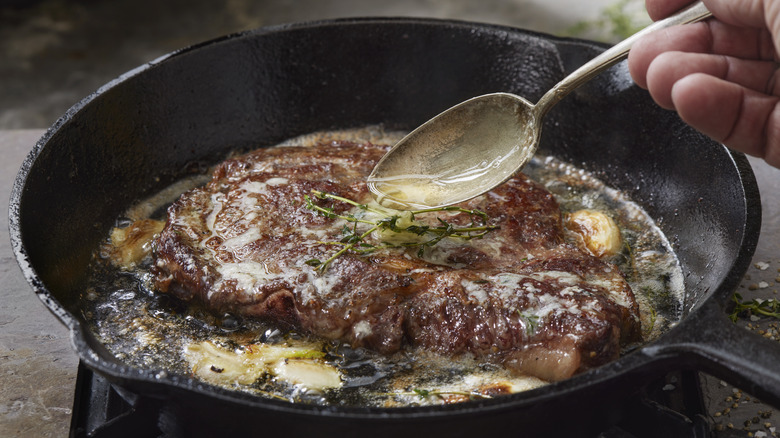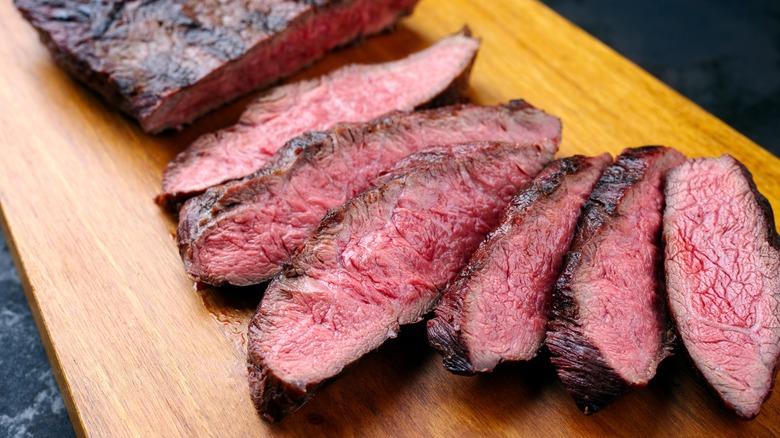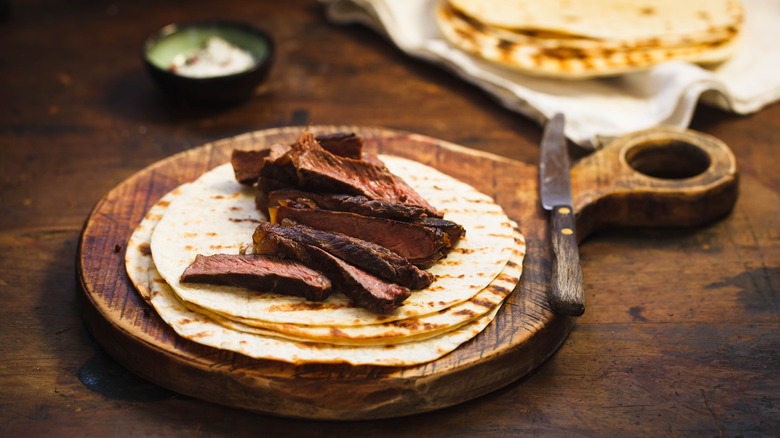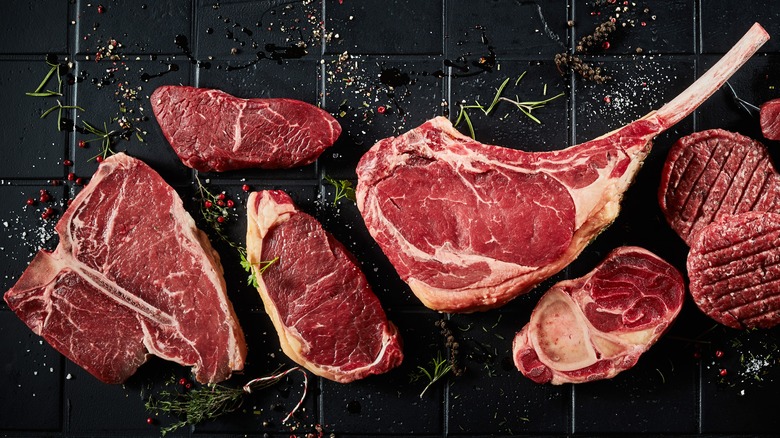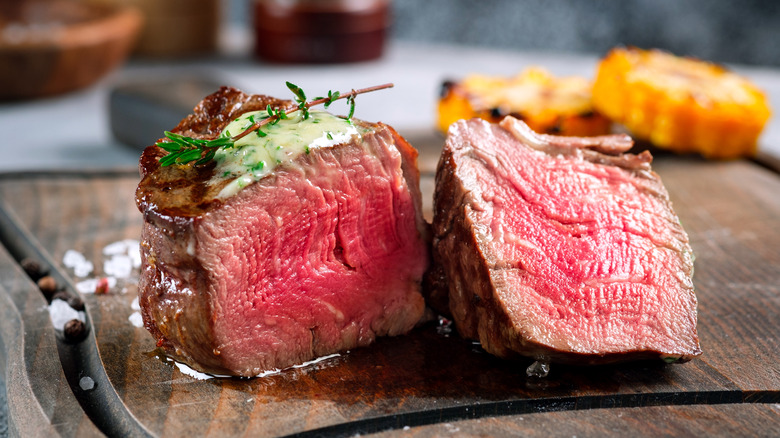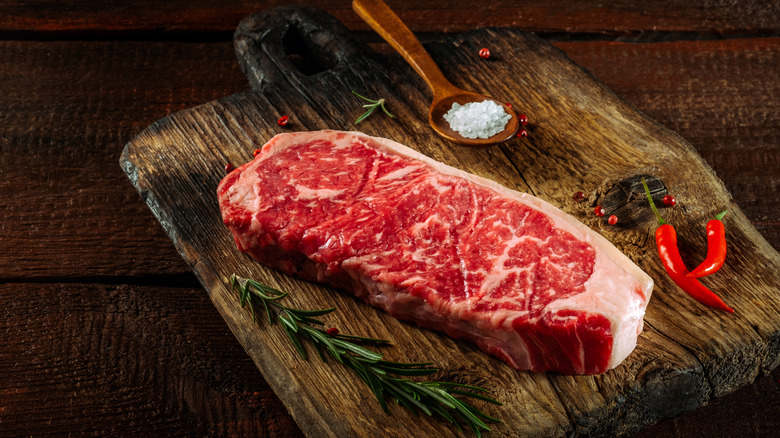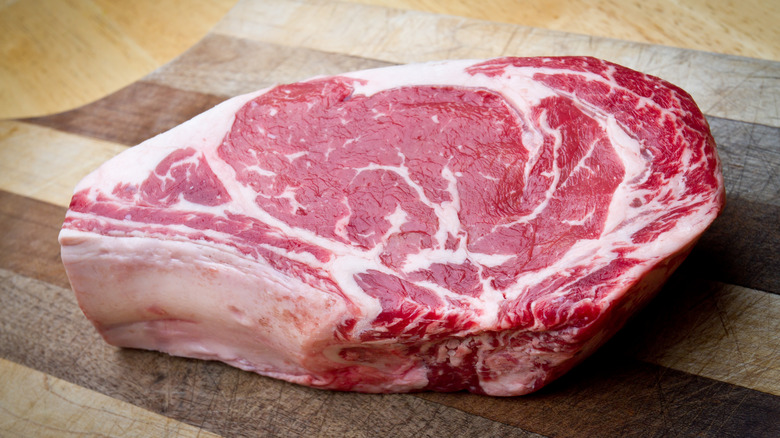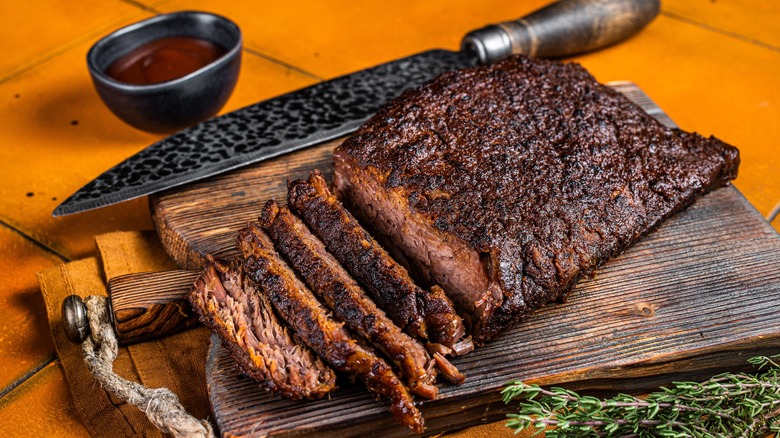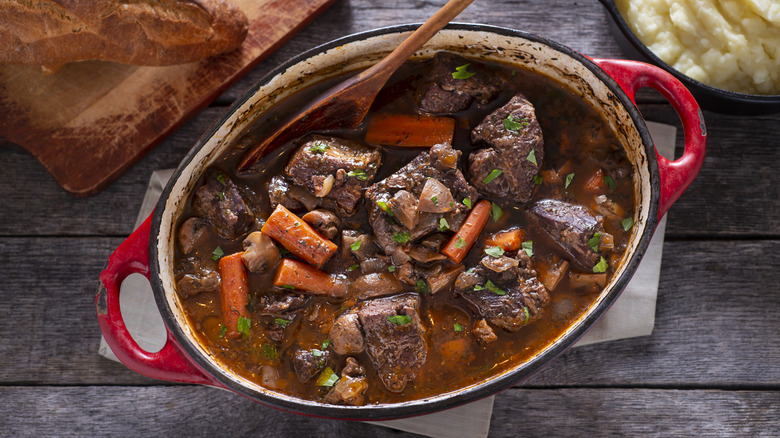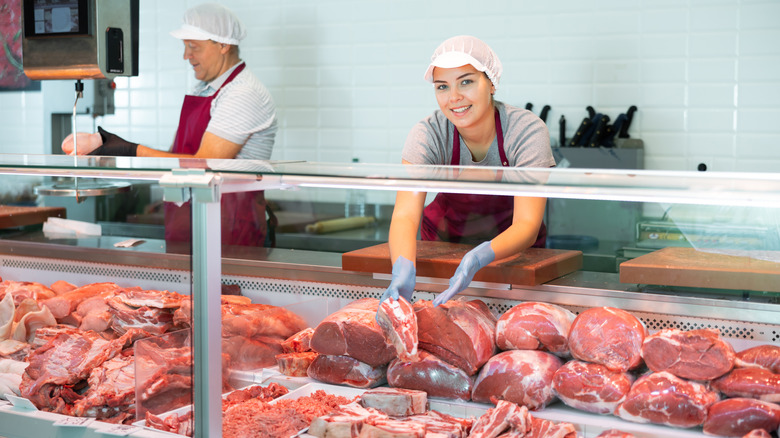Overrated Cuts Of Steak And What To Replace Them With
There's a lot of debate about the best cuts of steak. While personal taste plays a role — some people prefer a steak marbled with fat, while others opt for a leaner piece — quality and price point are also important considerations. Not to mention the occasion. Are you cooking a special anniversary dinner for your sweetheart, or trying to feed a large gathering of friends and family? These two scenarios may require different cuts of meat. For one thing, steak can be expensive, and you'll likely want to maximize value when serving a crowd. Some cuts of steak and beef are more budget-friendly. Moreover, you'll want to consider the preparation required for each cut and the specific dish you're cooking. There's no point in spending money on a ribeye if you're making steak tacos, for example. And if you're braising, you can definitely get away with a cheaper cut of beef.
Katelyn Leckie, chef at The Stop Community Food Centre in Toronto and co-founder of Not Your Parents' Wine, is often tasked with preparing quality meals for hundreds on a tight budget. With her additional experience as a private caterer, Leckie is perfectly poised to give us the scoop on her favorite cuts of steak to work with, which steaks are more affordable, and which are frankly not worth the price.
Bavette is the best beefy substitute for more expensive cuts
Bavette steak, an excellent cut of meat from the bottom sirloin, is sometimes referred to as "flap" steak. It is Katelyn Leckie's cut of choice when she wants something beefier than flank or skirt steak without splurging on a super thick, expensive cut. "It's tender and it's very beefy and it's very good," she tells Chowhound. Thicker than similar cuts, it appears juicier and more substantial on the plate, a plus when aiming to impress guests with a nice piece of meat. With its robust beefy flavor, it serves as a great alternative to more expensive cuts like ribeye and strip steaks.
Bavette is a versatile and tasty cut of beef. You can grill it on a barbecue, sear it in a cast iron skillet, or slice it up to share with friends. You may have noticed that bavette is increasingly appearing on restaurant menus. This cut is growing in popularity for good reason. Long cherished by butchers and connoisseurs, bavette strikes the perfect balance between ultra-pricey cuts and the tougher, more economical ones. Leckie serves it steak au poivre style, accompanied by a homemade peppercorn sauce.
Ditch the flank and swap in skirt steak
Bavette, skirt steak, and flank steak are all similar cuts from nearby parts of the cow. Bavette is the most expensive of the three, and the perfect substitute for a pricier cut like ribeye when you want something that looks plump and juicy on the plate. However, when you need to step down in price and don't mind a thinner cut, Katelyn Leckie tells us that skirt steak is more marbled than flank, making it more flavorful, and potentially more tender when prepared correctly.
According to Leckie, the key to these cuts is to slice them against the grain to help tenderize the meat when serving. " ... When you slice it against the grain, it shortens the fibers and makes it much easier to chew, much easier to digest." That's particularly crucial with skirt steak. Slice it correctly, and you'll have a tender, flavorful steak that everyone will enjoy. In fact, outside skirt steak is chef Pat LaFrieda's favorite cut.
It's an ideal cut for feeding a party. Leckie calls it "the skirt steak hack." Best served thinly sliced, a few skirt steaks can extend quite far. It absorbs marinade better than flank steak, making it perfect for carne asada or fajitas. Next time you're making steak tacos, definitely opt for skirt steak.
Don't throw a Tomahawk or a T-bone in the mix
The Tomahawk steak comes with a lot of pomp and circumstance, and a hefty price tag to match. You've likely seen it on a swanky restaurant menu for a steep $200. Sure, it's impressive, but is it worth your money? Probably not. Katelyn Leckie believes there's something primal about seeing a bone that people respond to. T-Bone steaks are similarly beloved for their "caveman reputation" — it's a human thing to enjoy seeing the bones of a big steak, which also "makes it look more expensive." It doesn't just look more expensive; it is. However, she thinks it's mostly about the optics. "When you get into those cuts that are so big, they are very impressive," she says, "but they're not often like the most beefy, the most tasty. They don't necessarily have the most flavor." What's the point of that, then?
When it comes to cooking one at home, it's often more trouble than it's worth. You'll be paying for that big bone when your butcher weighs your steak. And Leckie cautions that the actual meat on a T-bone can be surprisingly thin and therefore easier to overcook, which is devastating when you've paid a hefty price for your dinner. "I would say a T-bone steak is not your most tender of cuts anyway," she tells Chowhound. Replace it with a tasty marbled ribeye if you're in the mood for a splurge.
Filet mignon is probably a waste of your money
"The number one cut that comes to mind that I think is overrated is filet mignon," says Katelyn Leckie. Filet mignon is among the most expensive cuts available, and has become synonymous with luxury. It's tender and melts in your mouth when prepared perfectly, but it's also small and contains no marbling. It's probably not the right choice if you prefer a big, beefy steak with a bit of soft, succulent fat. No fat means less flavor. Plus, it's easier to overcook.
Filet mignon comes from the tenderloin of a cow. Leckie explains why this prized cut is so tender: "Basically, where the tenderloin is located, it's a muscle that the animal doesn't use very much. And so, when you get tough meat and tough cuts ... that's because the cow is using it constantly and it toughens up the fibers in the muscle ... a tenderloin is so deeply hidden. It's barely used while the animal's alive." That lack of use keeps it super tender. Hence, "tenderloin."
If you're going to shell out for filet mignon, you might consider getting a whole beef tenderloin instead, which can feed the whole party. "As a rule with meat in general," Leckie illuminates, "the less butchered it is, the cheaper it's going to be. So, because the filet mignon is so heavily butchered down to that medallion that people love the look of," that adds labor cost and makes it more expensive.
Strip loin steak is tender and easy to grill and share
Part of what makes filet mignon so expensive is the labor involved in perfectly butchering those tiny, tender medallions. That's part of what you're paying for. So, if you're in search of a more tender, less fatty cut, but you'd like a bigger piece of meat to throw on the grill, try a strip loin instead. Katelyn Leckie says strip loin is her cut of choice from this part of the cow, and her favorite steak to barbecue. There's just one large fat cap on one side of a strip loin, so those who prefer no fat in their meat can easily remove it, and those who enjoy a little fat or gristle to gnaw on will also be satisfied. It's a crowd-pleasing steak.
It's not exactly cheap, but, Leckie says, "a mistake people make that breaks the bank is giving people their own strip loin steak." You can always stretch value by slicing and sharing any cut of steak. According to Leckie, people often think about the length of a steak when trying to organize portions, but thickness is just as important. Grab a nice inch-and-a-half to two-inch thick strip loin, and "that's more than enough for two people."
To ribeye or not to ribeye, that is the question
Ribeye, typically a thicker steak from the rib area of the cow, is both tender and marbled with succulent (not gristly) fat. Many chefs and home cooks alike consider ribeye the best steak out there, with Michael Symon calling it "the king of steaks." However, it comes with a price tag to match.
Katelyn Leckie admits a ribeye is sometimes worth the splurge. "I think once in a while I'll definitely get like a big beautiful, perfectly marbled ribeye," she says. But you don't have to opt for ribeye when you're grilling for a crowd. And if you do decide to spoil your guests, definitely slice it up before serving. That way, fewer steaks go farther — and according to Leckie, you do not need to be serving every individual their own ribeye steak. Of course, if it's just too expensive, consider a bavette. Other leaner cuts can also be tenderized to approximate the ribeye.
As undeniably delicious as ribeye is, Leckie advises skipping it on restaurant menus, where you're likely to pay a large markup, and it's not hard to cook one yourself. Once you know the basics, steak is simple to prepare. Leckie recommends saving your dining-out dollars for something truly unique. Then, when you're in the mood for a little splurge, that's when you should buy a nice ribeye from your local butcher. It will still be expensive, but much less so.
Choose short ribs for beefy flavor, and brisket for a wholesome dish
Brisket, short rib, shank, and eye of round are the tougher cuts of beef that benefit from being cooked low and slow for longer periods. These cuts are great when you're feeding a crowd, and when you want to cook ahead. However, some of these cuts tend to be pricier than others. Katelyn Leckie says that almost any cut can turn out beautifully if you have the time and skill to cook it. In her opinion, brisket is probably better value than short rib.
Brisket is a barbecue staple and a holiday favorite. It loves a long braise, and absorbs loads of flavor. But, truth be told, it can be a bit tougher and stringier than short ribs. Leckie thinks brisket actually works better when you want to feature other beautiful flavors in your dish. And, as always, you're paying for the neatly trimmed bones when it comes to those meaty short ribs.
"If you want something that's really beefy and really tastes like the meat was supposed to taste ... short ribs are a good route for a bit more money," says Leckie. But if you're more interested in using your beef as a canvas for other deep flavors, "like miso and chilies and garlic, and you want it to have ... a wholesome flavor profile," then Leckie says that round or brisket are better, more affordable options.
Cheap chuck will get the job done when stewing
A cheaper cut of beef you can usually find at your grocery store is called "chuck." Beef chuck comes from the shoulder of the cow, and it's probably one of the toughest cuts out there, because this muscle is heavily used during the animal's lifetime. This isn't the cut you want when you're grilling on the barbecue or quickly searing in a cast iron skillet. However, when it comes to making a stew, there's no reason not to opt for chuck.
Is there anything better than a hearty beef stew on a cold night? Next time you're faced with cooking a big family dinner, consider boeuf bourguignon. This classic French stew feels elevated, but doesn't have to be expensive to prepare. You'll get the most mileage out of your meat in this format, and you don't have to buy the best cut. Chuck, or even tougher beef neck, can be the underrated cut of beef that's perfect for braising.
"You just want to cook it down," says Katelyn Leckie. Enough time can solve the problem of tough meat. If you're popping ingredients into the slow cooker for a day, or stewing it for hours in your Dutch oven, chuck will be just fine.
Learn how to cut down on costs at the butcher counter
When you're choosing a piece of beef, remember that you're not only paying for the quality of the meat, but also the labor that goes into preparing the cut. The more bone present, the more weight you're paying for. The more heavily butchered, the more expensive it is. Often, Katelyn Leckie notes, "the bigger the cuts you can get, if you're being economical, the better."
Leckie encourages us to advocate for what we want when we head to the butcher counter. If you don't want to pay for bone, then ask for boneless! For instance, if you're buying a shoulder roast, a lot of butchers will include more bone, but if you ask, they'll often be willing to cut the piece you actually want and need.
And if you are willing to do a little of the work yourself, you will sometimes find a more affordable piece of beef that's less butchered in the first place. Butchers often charge for the perfectly trimmed filet or brisket. A few knife skills can upgrade your ability to work with the meat, and often cut the cost back a bit. You can save money if you're willing and able to do a little more work at home. Or not! If you don't mind more fat and sinew then don't bother trimming it all off. "I really like the fat and all that on my meat," says Leckie, "but not everybody does."
